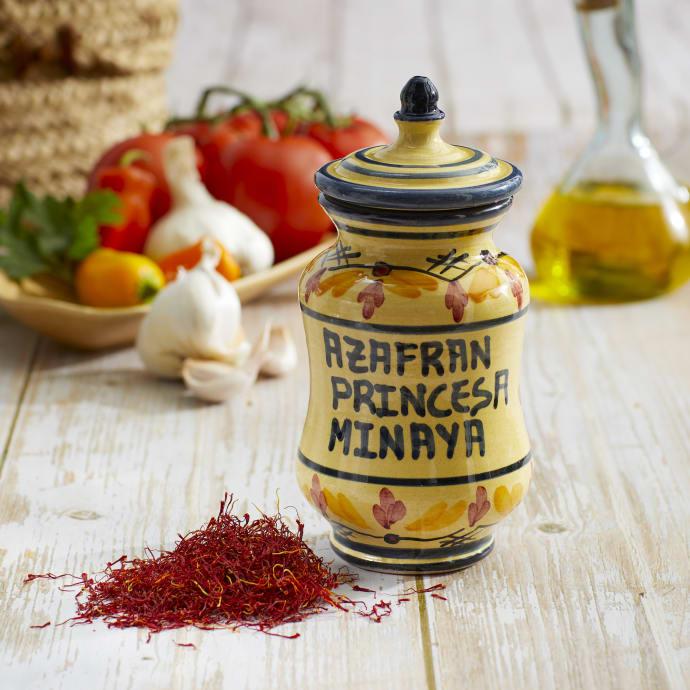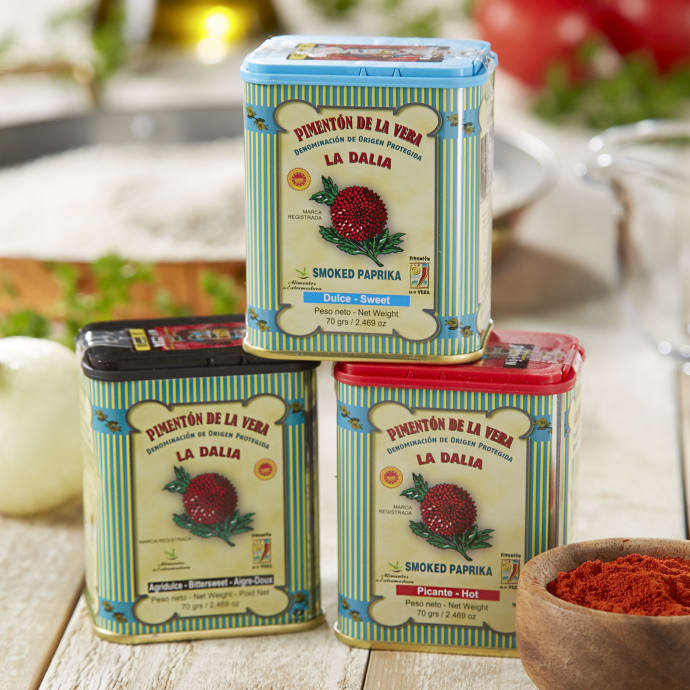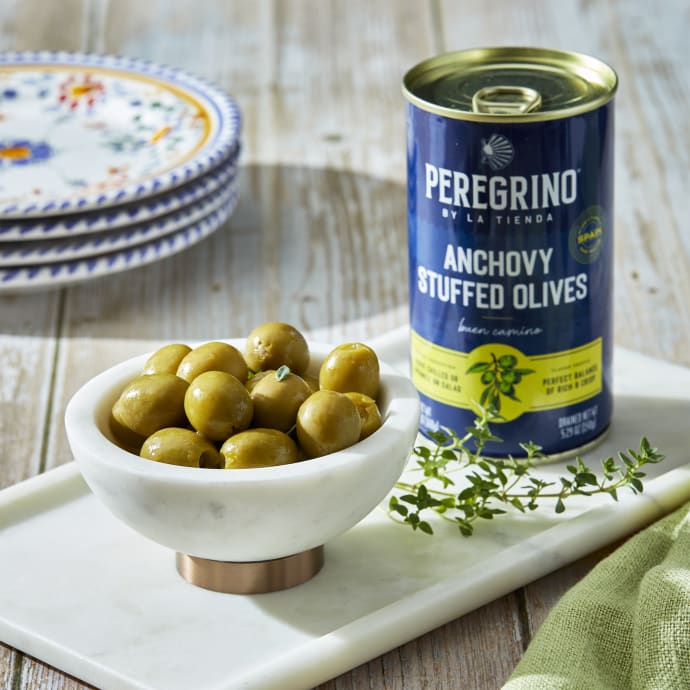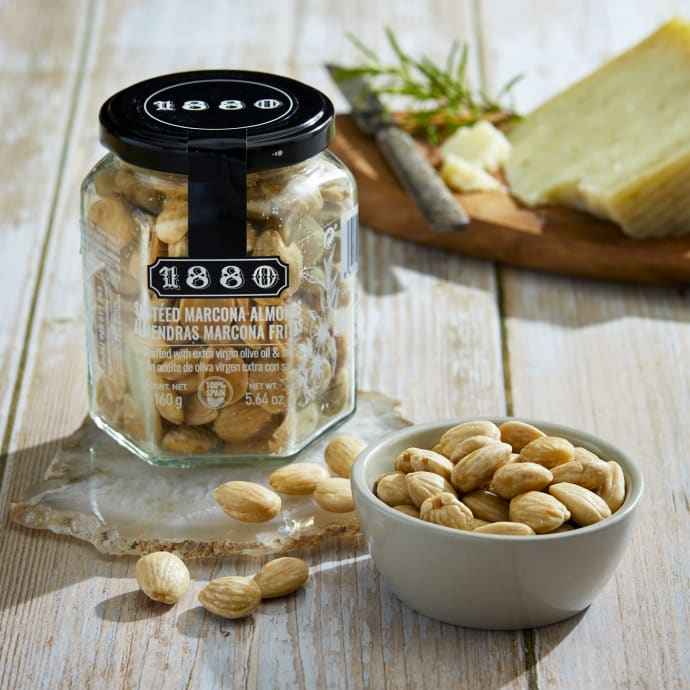
The spice of Spain
The Kansas City Star
-
August 2, 2006
With its garlic, olives and other heady flavors, the country's cuisine is invigorating America.
Star News Services
"Tapas are an inexpensive way to taste a lot of food without having to commit to a 40-bite chewfest or some big main course that bores me to tears a third of the way through." -- Celebrity chef Mario Batali
Spanish cuisine, an explosion of sizzling, colorful innovative fare, is all the rage not only in its native country but in the United States, too. Daring preparations by a generation of innovative chefs have made the cuisine hot, chic and casual. "Spain has really arrived," says Anya von Bremzen, author of The New Spanish Table (Workman Publishing, $22.95). "People have lost interest in French cooking, Italian has become too commonplace and everyone loves Mediterranean. Spanish cuisine is very simple, very minimalist and direct, but very striking and dramatic."
Among the hallmarks of Spanish cuisine are lots of smoky flavors. Olive oil, almonds, garlic, saffron, paprika, potatoes, rice, roasted red peppers, tomatoes, sausages, ham, olives (mostly green) and lamb play starring roles. Spain has one of the longest coastlines in Europe, so seafood also is a regular -- clams, shrimp, whole baked fish.
Spaniards are restrained in their cooking, allowing one major ingredient in a dish to solo. "Spanish cooking is about one ingredient tasting very good, like tossing sardines with garlic and parsley and leaving it alone," von Bremzen says. "Even when chefs riff on it, they don't put a lot on the plate."
In the last 10 years Spain has become one of the most interesting places in the world to eat because of the new-wave creative chefs who use science and theory and creative design in their dishes, von Bremzen says.
At his world-famous restaurant El Bulli, north of Barcelona, chef Ferran Adria has snared the international spotlight by applying science to cooking. Adria, the Salvador Dali of the culinary world, deconstructs traditional dishes and mixes unusual ingredients, such as chocolate and salt.
"People wanted to shake off the old lifestyle," says von Bremzen, whose book combines new and classic recipes. "Eating new food was part of being modern. The Spanish are very adventurous."
In her book, von Bremzen serves up 300 authentic recipes from a wealth of sources -- chefs, tapas bars, market vendors, taxi drivers, Spanish food writers, restaurant critics, cheese makers and so on.
Spain's most familiar and widely copied dining format -- tapas, or small-plate noshing -- puts flexibility on the menu. With tapas, hosts can show off their skills at multiple dishes, or fudge it by mounting last night's stew atop crusty bread slices accompanied by bowls of olives and almonds.
"Tapas provides the freedom to have not one but six, seven, eight dishes," says Jose Andres, author of Tapas: A Taste of Spain in America (Clarkson Potter, $35), written with Richard Wolffe. "It's the union of the high-end tasting menu and informal cooking. Tapas gives you the freedom in a simple, informal way to share a lot of things.
"There are no rigid rules. ... Almost anything can be served in small portions."
Andres considers himself a hybrid, melding traditional Spanish cooking and dishes with the bounty of local ingredients in the United States. Geared to home cooks, his book doesn't require special expertise.
Getting some of the ingredients for Spanish cooking may require planning. Specialty food stores and larger supermarkets will carry some of the special cheeses and olives, or look on Internet sites such as www.latienda.com
Did you know?
The word "tapa" literally means lid. The first tapas were pieces of bread used to cover wine glasses to keep out the flies, according to author Peter S. Feibleman in The Cooking of Spain and Portugal.
Green olives filled with piquillo peppers and anchovy
Makes 4 servings
8 extra-large green olives, unpitted
4 oil-packed anchovy fillets
2 piquillo peppers (see note)
1 garlic clove, unpeeled
3 tablespoons Spanish extra-virgin olive oil
Grated zest of 1/2 orange
1 tablespoon sherry vinegar
Sea salt to taste
Using the flat side of a knife, press each olive until pit pops out, being careful not to split the olive in half. Cut the anchovy fillets lengthwise to create 8 long slices, and cut the piquillo peppers into 8 ( 1/2 -inch-wide) strips.
Place 1 anchovy slice and 1 pepper strip in each olive. You can be generous with the filling, allowing the anchovy and pepper to spill out of the olive.
Split open garlic clove by placing it on a chopping board and pressing down hard with the base of your hand or with the flat side of a knife. In a small bowl, mix garlic, olive oil, orange zest and vinegar. Place stuffed olives in dressing and allow to marinate 30 minutes. Then sprinkle with a little sea salt and arrange on a plate, with toothpicks for serving.
Note: Piquillos are Spanish wood-roasted sweet peppers available in jars at specialty markets. Per serving: 122 calories (82 percent from fat), 11 grams total fat (2 grams saturated), 3 milligrams cholesterol, 4 grams carbohydrates, 2 grams protein, 255 milligrams sodium, 1 gram dietary fiber.
Tortilla with potatoes, artichokes and peppers
Makes 4 to 6 tapas servings
4 tablespoons olive oil, plus more if needed, divided
1/2 medium onion, quartered and thinly sliced
1 large boiled Yukon Gold potato, quartered and thinly sliced
3 marinated artichoke hearts, rinsed, patted dry and thinly sliced
1/4 cup sliced Spanish piquillo peppers (from a jar or can) or roasted red bell peppers (see note)
4 large eggs
2 tablespoons chicken stock or broth
Coarse salt (kosher or sea)
Heat 2 tablespoons olive oil in a medium skillet over medium heat. Add onion and cook until limp but not brown, 3 to 5 minutes. Add potato and cook, stirring gently, 5 minutes. Stir in artichokes and peppers and cook, stirring, 2 to 3 minutes longer. Using a slotted spoon, transfer vegetable mixture to a bowl and let cool completely.
Place eggs, chicken stock or broth, and a few small pinches of salt in a medium bowl and beat until just scrambled. Add potato mixture and stir until well-combined. Let stand about 10 minutes.
Heat remaining 2 tablespoons olive oil in a heavy 8-inch nonstick skillet over medium-high heat until it just begins to smoke. Pour egg mixture into skillet and flatten it with a spatula until the top is fairly even. Reduce heat to medium-low. Cook, moving and shaking the skillet, running a thin spatula around the edge and sliding it into the middle so some of the egg runs under. Cook tortilla in this fashion until top is a little wet but not liquid, about 5 minutes.
Run the thin spatula under the tortilla to make sure no part of the bottom is stuck to the skillet. Top skillet with a rimless plate slightly larger than the skillet and, using oven mitts, quickly invert tortilla onto plate. If skillet looks dry, add more olive oil. Slide tortilla back into skillet, uncooked side down. Shake skillet to straighten tortilla and push in edges with spatula. Reduce heat to very low and cook tortilla until a toothpick inserted in the center comes out dry, 3 to 4 minutes. Invert tortilla onto a serving plate and pat the top with a paper towel to get rid of excess oil. Let it cool a little, then cut tortilla into wedges. To serve as tapas, cut tortilla into squares and serve with toothpicks.
Note: Piquillos are Spanish wood-roasted sweet peppers available in jars at specialty markets. Per serving, based on 4: 234 calories (70 percent from fat), 19 grams total fat (3 grams saturated), 216 milligrams cholesterol, 3 grams carbohydrates, 9 grams protein, 312 milligrams sodium, 4 grams dietary fiber.
Rustic bread with dark chocolate, olive oil and salt
Makes 4 servings
4 ( 1/2 -inch-thick) slices rustic bread (see note)
4 ounces dark chocolate
4 tablespoons Spanish extra-virgin olive oil
Sea salt to taste
Toast bread slices until brown. Using a knife, break chocolate into small pieces. Scatter over toasted bread and place in a preheated 200-degree oven until chocolate melts, about 5 minutes.
Drizzle with olive oil, sprinkle a little salt on top and serve.
Note: Use country bread with a thick crust and a light interior full of holes, not a dense sourdough. Per serving: 323 calories (60 percent from fat), 23 grams total fat (2 grams saturated), no cholesterol, 30 grams carbohydrates, 4 grams protein, 184 milligrams sodium, 2 grams dietary fiber.
Sizzling garlic shrimp
Makes 4 tapas servings
1/4 pounds small shrimp, peeled and deveined 1
Coarse salt (kosher or sea)
1 cup fragrant extra-virgin olive oil
6 large garlic cloves, finely chopped
1/2 small dry red chili, such as arbol, crumbled
2 to 3 tablespoons minced fresh flat-leaf parsley
Country bread, for serving
Pat shrimp dry with paper towels, then sprinkle shrimp with salt. Place olive oil and garlic in a 10- to 11-inch large, heavy skillet and heat over medium-low until oil shimmers and garlic begins to sizzle gently. Cook until garlic is very fragrant but not colored, 2 to 3 minutes, reducing heat if necessary. Add chili and stir a few seconds. Add shrimp and cook, stirring, until they just begin to turn pink, about 3 minutes. Season with salt to taste, stir in parsley and cook a few seconds longer. Serve shrimp with plenty of bread alongside.
Per serving: 638 calories (80 percent from fat), 56 grams total fat (8 grams saturated), 217 milligrams cholesterol, 3 grams carbohydrates, 29 grams protein, 213 milligrams sodium, trace dietary fiber.
Simple tapas party
A tapas party is an easy way to entertain. With careful shopping, you can do the whole party without cooking a lick. A basic Spanish menu:
Cheeses such as manchego, cabrales and mahon. Serve them on a tray with nuts and dried fruit.
Cured sausages, including chorizo (no relation to the greasier Mexican chorizo) and salchichon. If you are not able to find these, go with dry Italian salami.
Serrano ham, a cousin to prosciutto. Slice it thinly and cut in half horizontally.
Crusty bread and seasoned toasts or croutons
Green olives
Marcona almonds
Gourmet potato chips, such as Terra or Kettle
From bottles or jars: marinated mushrooms, olive tapenade, calamari in olive oil, smoked sardines in lemon-flavored olive oil, stuffed olives, marinated red peppers
Spanish wines. Serve them in plain juice glasses, as they do at tapas bars in Spain.
Star News Services
"Tapas are an inexpensive way to taste a lot of food without having to commit to a 40-bite chewfest or some big main course that bores me to tears a third of the way through." -- Celebrity chef Mario Batali
Spanish cuisine, an explosion of sizzling, colorful innovative fare, is all the rage not only in its native country but in the United States, too. Daring preparations by a generation of innovative chefs have made the cuisine hot, chic and casual. "Spain has really arrived," says Anya von Bremzen, author of The New Spanish Table (Workman Publishing, $22.95). "People have lost interest in French cooking, Italian has become too commonplace and everyone loves Mediterranean. Spanish cuisine is very simple, very minimalist and direct, but very striking and dramatic."
Among the hallmarks of Spanish cuisine are lots of smoky flavors. Olive oil, almonds, garlic, saffron, paprika, potatoes, rice, roasted red peppers, tomatoes, sausages, ham, olives (mostly green) and lamb play starring roles. Spain has one of the longest coastlines in Europe, so seafood also is a regular -- clams, shrimp, whole baked fish.
Spaniards are restrained in their cooking, allowing one major ingredient in a dish to solo. "Spanish cooking is about one ingredient tasting very good, like tossing sardines with garlic and parsley and leaving it alone," von Bremzen says. "Even when chefs riff on it, they don't put a lot on the plate."
In the last 10 years Spain has become one of the most interesting places in the world to eat because of the new-wave creative chefs who use science and theory and creative design in their dishes, von Bremzen says.
At his world-famous restaurant El Bulli, north of Barcelona, chef Ferran Adria has snared the international spotlight by applying science to cooking. Adria, the Salvador Dali of the culinary world, deconstructs traditional dishes and mixes unusual ingredients, such as chocolate and salt.
"People wanted to shake off the old lifestyle," says von Bremzen, whose book combines new and classic recipes. "Eating new food was part of being modern. The Spanish are very adventurous."
In her book, von Bremzen serves up 300 authentic recipes from a wealth of sources -- chefs, tapas bars, market vendors, taxi drivers, Spanish food writers, restaurant critics, cheese makers and so on.
Spain's most familiar and widely copied dining format -- tapas, or small-plate noshing -- puts flexibility on the menu. With tapas, hosts can show off their skills at multiple dishes, or fudge it by mounting last night's stew atop crusty bread slices accompanied by bowls of olives and almonds.
"Tapas provides the freedom to have not one but six, seven, eight dishes," says Jose Andres, author of Tapas: A Taste of Spain in America (Clarkson Potter, $35), written with Richard Wolffe. "It's the union of the high-end tasting menu and informal cooking. Tapas gives you the freedom in a simple, informal way to share a lot of things.
"There are no rigid rules. ... Almost anything can be served in small portions."
Andres considers himself a hybrid, melding traditional Spanish cooking and dishes with the bounty of local ingredients in the United States. Geared to home cooks, his book doesn't require special expertise.
Getting some of the ingredients for Spanish cooking may require planning. Specialty food stores and larger supermarkets will carry some of the special cheeses and olives, or look on Internet sites such as www.latienda.com
Did you know?
The word "tapa" literally means lid. The first tapas were pieces of bread used to cover wine glasses to keep out the flies, according to author Peter S. Feibleman in The Cooking of Spain and Portugal.
Green olives filled with piquillo peppers and anchovy
Makes 4 servings
8 extra-large green olives, unpitted
4 oil-packed anchovy fillets
2 piquillo peppers (see note)
1 garlic clove, unpeeled
3 tablespoons Spanish extra-virgin olive oil
Grated zest of 1/2 orange
1 tablespoon sherry vinegar
Sea salt to taste
Using the flat side of a knife, press each olive until pit pops out, being careful not to split the olive in half. Cut the anchovy fillets lengthwise to create 8 long slices, and cut the piquillo peppers into 8 ( 1/2 -inch-wide) strips.
Place 1 anchovy slice and 1 pepper strip in each olive. You can be generous with the filling, allowing the anchovy and pepper to spill out of the olive.
Split open garlic clove by placing it on a chopping board and pressing down hard with the base of your hand or with the flat side of a knife. In a small bowl, mix garlic, olive oil, orange zest and vinegar. Place stuffed olives in dressing and allow to marinate 30 minutes. Then sprinkle with a little sea salt and arrange on a plate, with toothpicks for serving.
Note: Piquillos are Spanish wood-roasted sweet peppers available in jars at specialty markets. Per serving: 122 calories (82 percent from fat), 11 grams total fat (2 grams saturated), 3 milligrams cholesterol, 4 grams carbohydrates, 2 grams protein, 255 milligrams sodium, 1 gram dietary fiber.
Tortilla with potatoes, artichokes and peppers
Makes 4 to 6 tapas servings
4 tablespoons olive oil, plus more if needed, divided
1/2 medium onion, quartered and thinly sliced
1 large boiled Yukon Gold potato, quartered and thinly sliced
3 marinated artichoke hearts, rinsed, patted dry and thinly sliced
1/4 cup sliced Spanish piquillo peppers (from a jar or can) or roasted red bell peppers (see note)
4 large eggs
2 tablespoons chicken stock or broth
Coarse salt (kosher or sea)
Heat 2 tablespoons olive oil in a medium skillet over medium heat. Add onion and cook until limp but not brown, 3 to 5 minutes. Add potato and cook, stirring gently, 5 minutes. Stir in artichokes and peppers and cook, stirring, 2 to 3 minutes longer. Using a slotted spoon, transfer vegetable mixture to a bowl and let cool completely.
Place eggs, chicken stock or broth, and a few small pinches of salt in a medium bowl and beat until just scrambled. Add potato mixture and stir until well-combined. Let stand about 10 minutes.
Heat remaining 2 tablespoons olive oil in a heavy 8-inch nonstick skillet over medium-high heat until it just begins to smoke. Pour egg mixture into skillet and flatten it with a spatula until the top is fairly even. Reduce heat to medium-low. Cook, moving and shaking the skillet, running a thin spatula around the edge and sliding it into the middle so some of the egg runs under. Cook tortilla in this fashion until top is a little wet but not liquid, about 5 minutes.
Run the thin spatula under the tortilla to make sure no part of the bottom is stuck to the skillet. Top skillet with a rimless plate slightly larger than the skillet and, using oven mitts, quickly invert tortilla onto plate. If skillet looks dry, add more olive oil. Slide tortilla back into skillet, uncooked side down. Shake skillet to straighten tortilla and push in edges with spatula. Reduce heat to very low and cook tortilla until a toothpick inserted in the center comes out dry, 3 to 4 minutes. Invert tortilla onto a serving plate and pat the top with a paper towel to get rid of excess oil. Let it cool a little, then cut tortilla into wedges. To serve as tapas, cut tortilla into squares and serve with toothpicks.
Note: Piquillos are Spanish wood-roasted sweet peppers available in jars at specialty markets. Per serving, based on 4: 234 calories (70 percent from fat), 19 grams total fat (3 grams saturated), 216 milligrams cholesterol, 3 grams carbohydrates, 9 grams protein, 312 milligrams sodium, 4 grams dietary fiber.
Rustic bread with dark chocolate, olive oil and salt
Makes 4 servings
4 ( 1/2 -inch-thick) slices rustic bread (see note)
4 ounces dark chocolate
4 tablespoons Spanish extra-virgin olive oil
Sea salt to taste
Toast bread slices until brown. Using a knife, break chocolate into small pieces. Scatter over toasted bread and place in a preheated 200-degree oven until chocolate melts, about 5 minutes.
Drizzle with olive oil, sprinkle a little salt on top and serve.
Note: Use country bread with a thick crust and a light interior full of holes, not a dense sourdough. Per serving: 323 calories (60 percent from fat), 23 grams total fat (2 grams saturated), no cholesterol, 30 grams carbohydrates, 4 grams protein, 184 milligrams sodium, 2 grams dietary fiber.
Sizzling garlic shrimp
Makes 4 tapas servings
1/4 pounds small shrimp, peeled and deveined 1
Coarse salt (kosher or sea)
1 cup fragrant extra-virgin olive oil
6 large garlic cloves, finely chopped
1/2 small dry red chili, such as arbol, crumbled
2 to 3 tablespoons minced fresh flat-leaf parsley
Country bread, for serving
Pat shrimp dry with paper towels, then sprinkle shrimp with salt. Place olive oil and garlic in a 10- to 11-inch large, heavy skillet and heat over medium-low until oil shimmers and garlic begins to sizzle gently. Cook until garlic is very fragrant but not colored, 2 to 3 minutes, reducing heat if necessary. Add chili and stir a few seconds. Add shrimp and cook, stirring, until they just begin to turn pink, about 3 minutes. Season with salt to taste, stir in parsley and cook a few seconds longer. Serve shrimp with plenty of bread alongside.
Per serving: 638 calories (80 percent from fat), 56 grams total fat (8 grams saturated), 217 milligrams cholesterol, 3 grams carbohydrates, 29 grams protein, 213 milligrams sodium, trace dietary fiber.
Simple tapas party
A tapas party is an easy way to entertain. With careful shopping, you can do the whole party without cooking a lick. A basic Spanish menu:
Cheeses such as manchego, cabrales and mahon. Serve them on a tray with nuts and dried fruit.
Cured sausages, including chorizo (no relation to the greasier Mexican chorizo) and salchichon. If you are not able to find these, go with dry Italian salami.
Serrano ham, a cousin to prosciutto. Slice it thinly and cut in half horizontally.
Crusty bread and seasoned toasts or croutons
Green olives
Marcona almonds
Gourmet potato chips, such as Terra or Kettle
From bottles or jars: marinated mushrooms, olive tapenade, calamari in olive oil, smoked sardines in lemon-flavored olive oil, stuffed olives, marinated red peppers
Spanish wines. Serve them in plain juice glasses, as they do at tapas bars in Spain.
Other Press
La Tienda Partners with William & Mary to Expand Cultural and Educational Ties to Spain
WYDaily
-
January 5, 2026
Six Bottles, Five Countries: Traveling The World Through Olive Oil
Forbes
-
January 3, 2026
Williamsburg business helps clear student lunch debt for WJCC students
WAVY News
-
December 30, 2025
The Winter Travel Shortlist: Problem-Solving Essentials I’m Packing This Season
Forbes
-
November 20, 2025
Featured Products

Roasted Piquillo Pepper Slices
PQ-04
(19)
$15.00$15.00

Spanish Tortilla Flipper & Server
CM-08
(5)
$45.00$45.00

Saffron in Hand-Painted Jar by Princesa de Minaya
SN-03
(20)
$59.00$59.00

Smoked Paprika Trio by La Dalia
PK-12
(54)
$22.00$22.00

Terra Cotta Cazuelas - 4.5 Inches (4 Dishes)
CA-27
(11)
$34.00$34.00
 BEST SELLER
BEST SELLERAnchovy Stuffed Olives by Peregrino - 'Extra' Quality
OL-03
(91)
2 for $14.00$14.00

Gourmet Marcona Almonds
NT-08
(36)
$19.00$19.00







